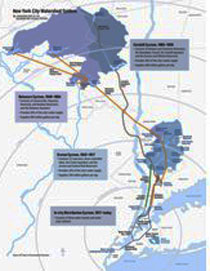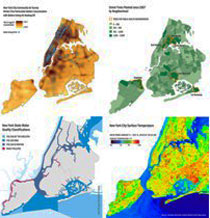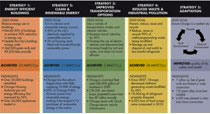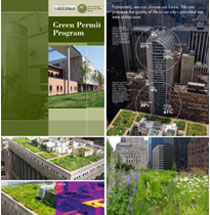
Policies for sustainability. Virtuous examples in U.S.A, Michele Manigrasso |
 |
Outline a framework of policies for environmental sustainability of cities in the U.S. through the examination of documents that regulate and certify an operation is highly complex, given the breadth of the topic and the many experiences that have now been put in place. In fact, the theme is much debate and the climate is of great turmoil, there is now everywhere the need to increase the resilience of urban and regional planning, to expand time horizons in spite of those usually considered by planning policies, people give up to the modern and deterministic vision of urban thing. It should be able to make choices that can foresee ever-changing needs, providing ever-changing scenarios, sometimes with a good dose of creative intuition, anticipating science knowledge if it has not gave yet reliable answers, especially regarding the possible environmental implications of consumption soil resources of the levy, the rate of pollution, etc ..., implemented from the existing socio-economic development, a model which is not sustainable and replicable.
The documents that can offer an insight of U.S. policies can be applied to many aspects of urban: from the open spaces of the building, from the technological infrastructure and mobility to natural and ecological resources. You can for example refer to the well-known system of energy certification LEED (acronym of Leadership in Energy and Environmental Design), international protocol for classification and certification of sustainable buildings, which dates back to 1998, first working in the U.S. from the U.S. Green Building Council (USGBC). Otherwise you may refer to policies focused on sustainable transports, such as the plan "U.S. Drive", issued by the U.S. Department of Energy last August, described as a "guide the research and innovation in vehicle efficiency and sustainable energy ", supported by U.S. President Barack Obama and aimed to bring about roads 1 million electric vehicles by 2015. You can extend the argument to a national, federal, as well as urban, taking into account policies on forest protection, biodiversity more generally, systems of savings and more efficient management of water resources and many other policies.
It is important, however, in order to restore a vision of an interest in the practice of architectural design and town planning in the urban context, to examine those documents of which some cities are provided in order to guide their own development strategies, as well as, to achieve sustainable urban projects with outcomes environmental, even on the spatial context.
One of the most interesting cases is the New York PlaNYC, a plan of 2006, launched by Mayor Bloomberg on the occasion of Earth Day. This is a key to sustainable strategic plan titled "A Greener, Greater New York", which contains 127 initiatives with the goal to reduce of 30% by 2030, greenhouse gas emissions. The plan, adopted in 2007 and monitored periodically, is divided into 5 sections: soil, water, transport, energy, air and climate change. The actions are divided on the following policies: living, open spaces, abandoned areas, water quality, water, transport, energy, air quality and climate change. To understand the nature of cross-disciplinary initiatives is useful to read an excerpt:
“The concept of “sustainability” brings together economic, social, and environmental considerations precisely because these goals are inter-related. Solutions in one area can bring benefits in another. Similarly, we have approached this plan holistically, not as a series of separate challenges. Each initiative achieves multiple ends. Some, in fact, rely on others; for example, we cannot meet our air quality goal if we do not also reduce road congestion. And virtually every initiative in this plan contributes to the global fight against climate change, because enabling the most energy- and land-efficient city in America to grow will help reduce our nation’s global warming emissions”.
We recommend to review the structure of the strategies and the actions through the tables published in the plane (http://www.nyc.gov/html/planyc/html/home/home.shtml), which show the rich array of initiatives, classified compared to 5 subjects, but strategically thought in a transverse manner in order to achieve the primary goals specific, with effects also on other sectors. The update released of the last April, of the 127 proposed initiatives in 2007, the 97% is to be started. The results are already remarkable:
Realization and re-use of 64.000 home units; 20 rezonings approved, focusing development in areas well-served by transit; 100,000 affordable units created or preserved under the New Housing Marketplace Plan; 322,497 trees planted and 113 schoolyards to playground sites opened; Office of Environmental Remediation created, becoming nation’s first municipal brownfield office; Over 28,600 acres of land acquired to protect our upstate water supply; 200 miles of bicycle lanes installed and bike access law enacted; Times Square, Herald Square, and Madison Square transformed into pedestrian-friendly plazas; 31 state-of-good repair projects begun, leveraging $261 million in Federal stimulus funding; Greener, Greater Buildings Plan enacted into law, requiring energy efficiency upgrades in all large buildings; All 14 wastewater treatment plants now able to meet the Clean Water Act’s standard for pollutant removal harbor-wide; 84 energy efficiency projects completed as part of plan to reduce City government energy use 30% by 2017; 25% of the yellow taxi fleet converted to hybrid vehicles; Clean air school bus law enacted, requiring installation of interior air quality controls on entire fleet; 9% decrease in citywide carbon emissions; Developed city’s first official climate change projections.
The plan is a "control room" that organizes with a flexibility and a dynamic vision the policy of sustainable concept by monitoring the developments with the ability to change the objectives and the tools related to the inevitable mutability of context conditions.
Another test case for the analysis of sustainability policies in the U.S. is the "Chicago Climate Action Plan" of Chicago itself. Since 1980 the average temperature in Chicago has risen by 2.6 ° C, so the city, during 2008, has been endowed by an action plan which aimed at prediction of future climate scenarios in the city and all the consequent impacts. The plan consists of five axes shown in the table. (http://www.chicagoclimateaction.org/)
It is interesting in this plan to highlight all the many strategies as well as programs, arisen after an emergency mobilization against the possible risks, and retraining and sustainable developments. As an example, cites the "Green Permit Program", an incentive program that encourages developers to incorporate eco-design in building projects. Among the solutions promoted by the program green roofs are included. The incentives expect for those who take the solutions promoted, that the licensing procedures follow a lane privileged reduction of waiting times and remarkable affordability. Tax deductions are then applied (similar to our 55%), a mix of direct support (co-financing, technical support, volume bonuses) and the requirement to have green roofs to operators who receive public support, for example in the case of redevelopment of brownfield sites. The incentives also promote the system of eco-design and LEED certification. To 2008 were made at about 400 green roofs, for a total of 50,000 square meters. The Chicago Climate Action Plan sets a target of 6,000 green roofs to reach by 2020. Even on the town hall was built a green roof, on which was recorded a temperature of 34 ° C 66 ° C against the roof of the building located next door, traditionally coated with bitumen.
The program, as well as other initiatives translated into laws and regulations, creates an agenda constantly monitored, flexible and effective, which shows significant results in the area and, therefore, worthy of being enrolled among the experiences of sustainable planning in the world to which we should pay attention.
 |
EWT/ EcoWebTown |




